Medinet HabuThe mortuary temple of King Ramesses III at Medinet Habu on the west bank of the Nile opposite Thebes (modern-day Luxor).
Medinet Habu is found in the golden city of Luxor on the west bank of the Nile River in the southern district of the Theban necropolis which is known to be associated with the gigantic and preserved Mortuary Temple of Ramesses III.
In order to reach Medinet Habu, you will simply hire a travel agency that will provide a tour guide and a skilled driver with a private car that showcases the beauty and greatness of this immortal attraction.
The History of Medinat Habu
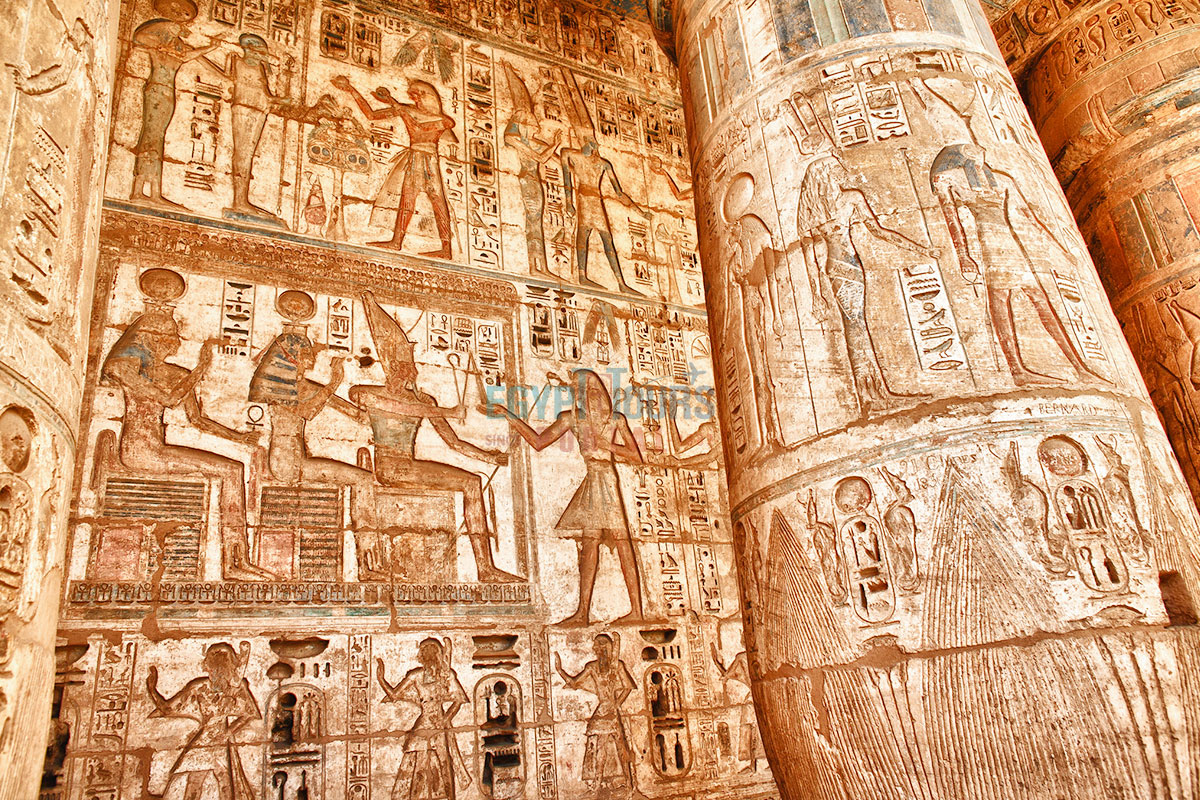
Medinat Habu was built during the New Kingdom (1570 – 1050 BC) by Ramses III (1184 – 1153 BC) the second Pharaoh of the 20th dynasty. Medinet Habu was for centuries the center of the economic life of Thebes. The oldest construction on the site was an Eleven dynasty (2081 – 1938 BC) small shrine that was later enlarged by Thutmose III and Hatshepsut to honor the creator god Amon and the Primeval Ogdoad which is an Eight Deities from the Middle Kingdom.
It was abandoned in the 3rd intermediate period (1075 – 656 BC) and acted as a private cemetery. The temple held a row of funerary chapels to the so-called wives of Amun during the 20th, 25th, 26th, 29th, and 30th Dynasties plus in the same dynasties and the Greco-Roman were a number of various modifications and alterations.
The Purpose of Medinet Habu
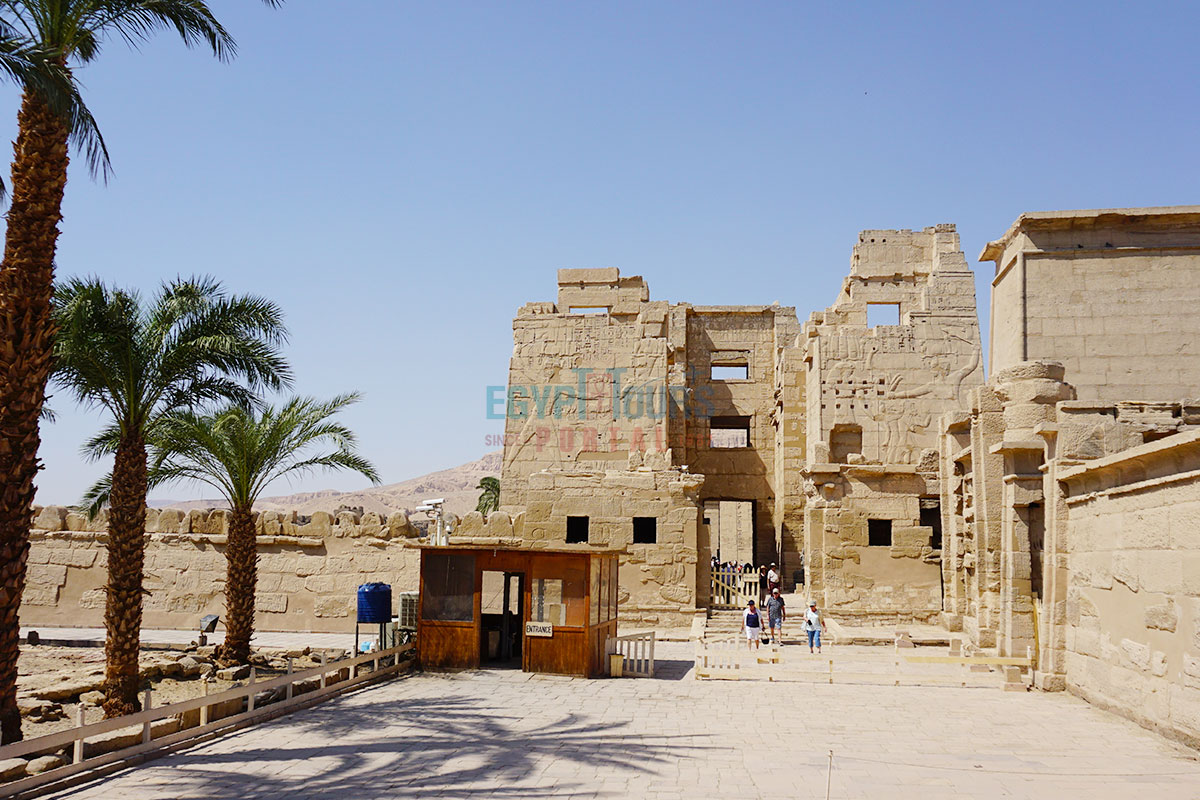
Many may wonder why is the Medinet Habu important and what it was Medinat Habu used the answer is that The archaeological wonder of Medinet Habu is a fortified construction that was a highly important religious center dedicated to the God Amun and a Pharaonic power base within western Egypt.
It was used in times of conflict for protection for the western inhabitants of Thebes and as a center for the Dayr al-Madinah women’s village. The complex was also a walled and fortified town for the Coptic Christians in the 9th century AD. It was designed to display military might and celebrate victory in battles against the sea people, Libyans, and Nubians.
The Construction of Medinet Habu
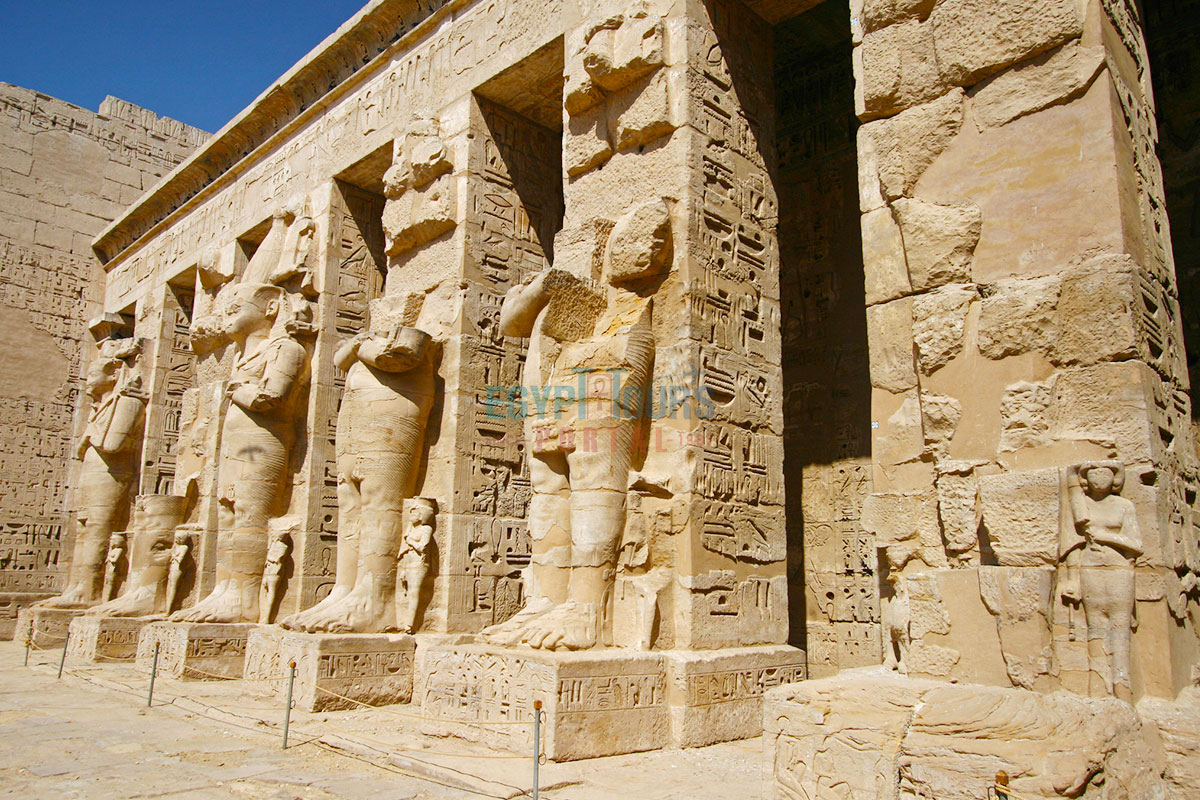
It is the second biggest ancient temple ever constructed on an area of 66,000 square meters on the west bank of the Nile River at the feet of the Theban Hills in the opposite city of Luxor. The Temple measures 200 m in width from the north to the south and 320 m in length from the east to the west.
It is one of the most underrated attractions in Thebes, containing a number of temples, workshops, storage rooms, a royal palace, administrative buildings, and accommodations for officials and priests. It is one of the largest memorial temples in all of Egypt and contains between its gates the temple of Amun, The temple of Ramesses III, and the temple of Ay & Horemheb. It has many courtyards with columns and reliefs that contain the finest and highly intact coloring that leads to a majestic hypostyle hall.
The Interior of Medinet Habu
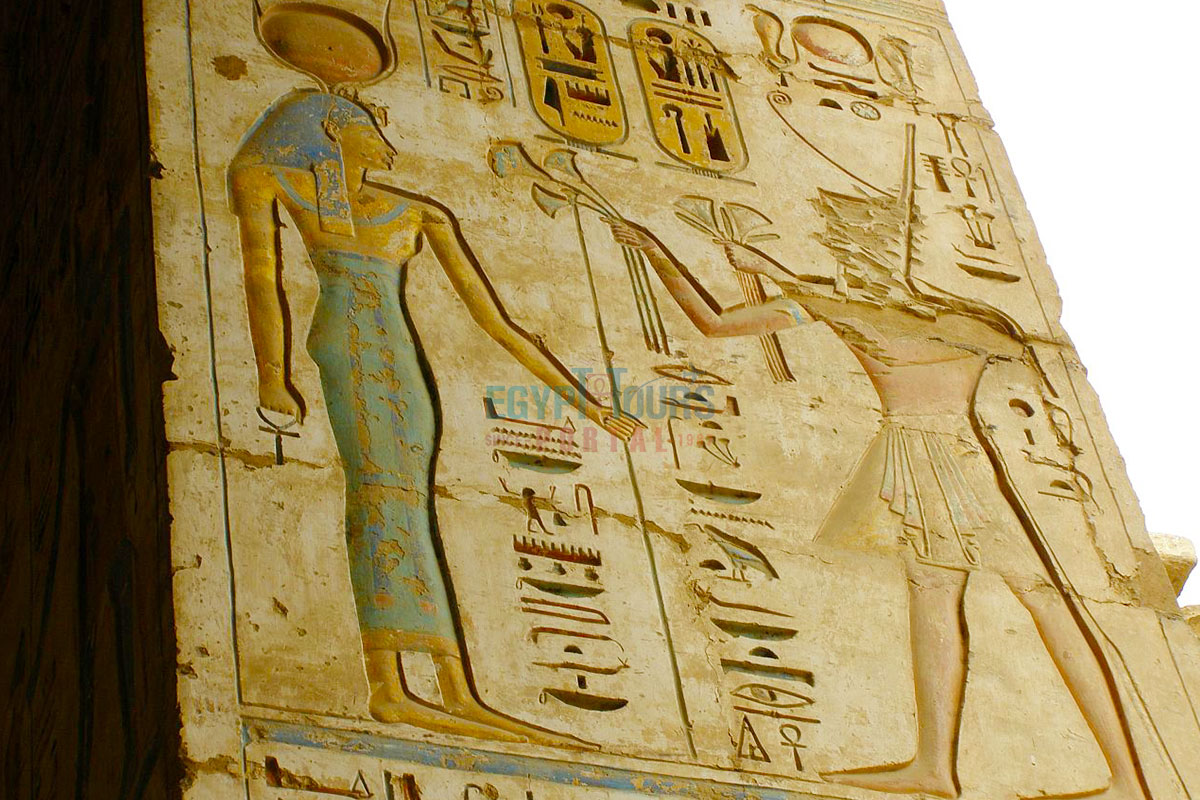
The entire construction is made up of a massive gate in the design of a Syrian fort which is decorated and carved with many battle scenes showcasing Ramsess III’s war with the Syrians. Behind the gate is an incredible shrine that dates back all the way to the 18th dynasty. The temple was a wide-open court that led directly to a massive pylon with both of the towers that are decorated with battle scenes such as the king wearing a red crown with the KA, while he is defeating his enemies in the presence of Re-Horakhty and another with the king wearing lower Egypt red crown which smiting his enemies in the presence of Amun-Ra. On the southern tower is an engraved scene of an Oxen Hunt with Ramses II riding his chariot.
The first open court is about 33m wide by 42m long and is decorated with many battle scenes of a war between the Egyptians and the Syrians & Libyans. The second courtyard is about 38m wide by 42m long and holds a small lake it became a basilica in the early Christian era and is filled with scenes of religious ceremonies like the festival and min and Sokar plus other scenes with many holy priests and kings providing offerings to the ancient Egyptian gods.
The first Hypostyle was rocked by an earthquake in 27 BC which once held 24 columns divided into six rows plus surrounded by 16 chapels. Some of the most significant shrines in the temple are the one dedicated to King Ramses III, the second dedicated to Ptah, chapel number four is consecrated for the Sokker Boat, and the seventh chapel dedicated to a sacred boat of Amun-Ra. The chapels on the left side are where the utensils of the temple are stored, chapel number 14 that are dedicated to the divine boat of Pharaoh Ramses II, and Chapel number 15 is dedicated to the sacred boat of Montho. The 2nd hypostyle hall contains eight papyrus columns in two rows while the ceiling is supported by eight columns in two rows. The Hypostyle hall has an end that possesses three entrances the entrance in the center leads to the sanctuary that is dedicated to the Theban triad where the Amun-Ra sacred boat is found, the chapel of god Khonsu on the left side leads to the chapel of Mut.
Temple of Ramesses III

The magnificent Temple of Ramesses III is found in the incredible ancient structure of Medinet habu that was built in the new kingdom (1570 – 1050 BC) on the west bank of Luxor. The site is recognized for its amazing architectural significance plus its epic size. This phenomenal structure has a number of legendary inscribed reliefs showcasing the defeat of the great sea people during the reign of Ramesses III. The temple is 150 m long and has a design similar to the close mortuary temple of Ramesses II. The entrance of the temple is through a powerful stronghold gatehouse. The temple is filled with highly preserved walls surrounded by a substantial fortified mudbrick enclosure. Within the enclosure are a number of chapels dedicated to the Divine Adoratrices of Amun. The colossal temple contains colossal statues of Ramesses III, peristyle halls, courtyards, and a large hypostyle hall.
There are many decorations and reliefs found on the walls which symbolize the Pharaoh’s control over regions like Nubia and Syria. In the Coptic age, a church and Christian carvings were added to the temple’s walls. Its greatest possession includes the list of Medinet Habu King on the eastern wall in the second courtyard, which hold celebrations of 9 pharaohs and document plus celebrates the festival of min. The temple was detailed around 1829 by Jean-François Champollion. Between the years of 1859 and 1899, many excavations took place where a number of Greco-Roman structures plus a Byzantine church were destroyed. Around 2014, many excavations were done by the University of Chicago Oriental Institute.
Sea Peoples at Medinet Habu
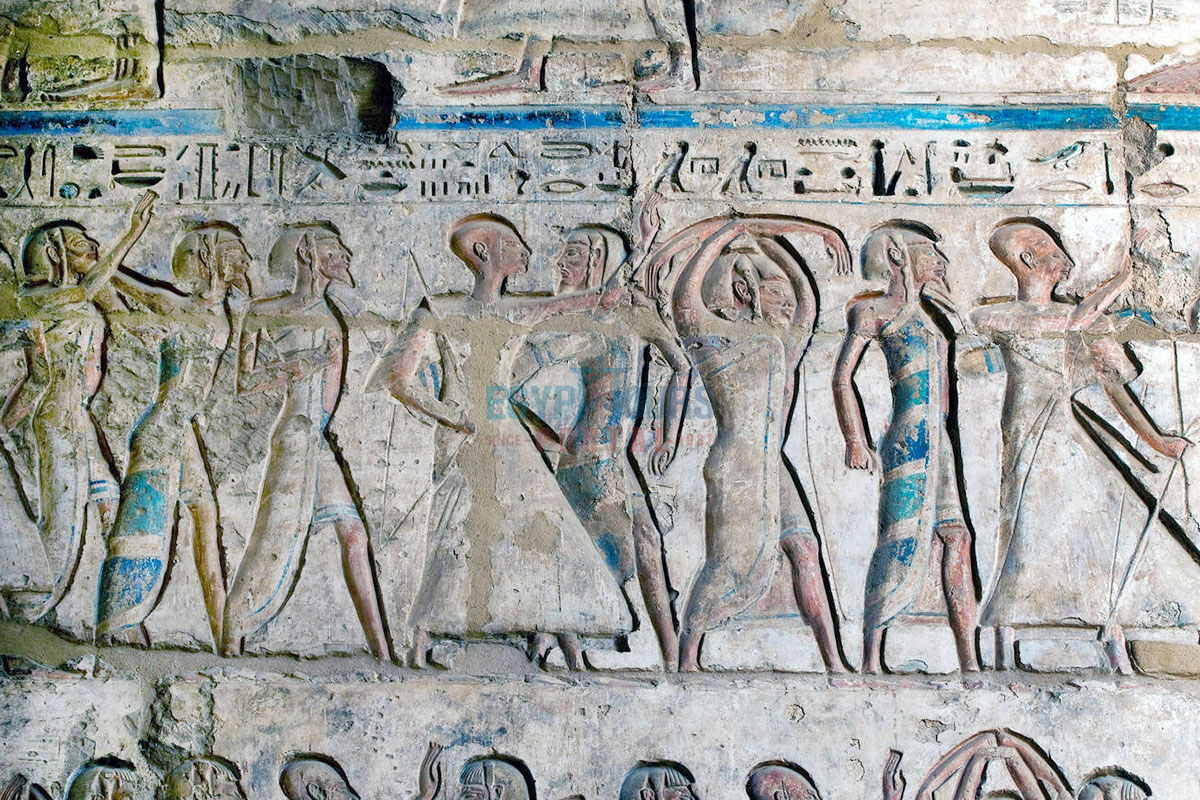 Sea Peoples at Medinet Habu – Egypt Tours Portal
Sea Peoples at Medinet Habu – Egypt Tours Portal
Medinet Habu is a true piece of magic and art with a great wealth of knowledge as all the reliefs and inscriptions are able to showcase a number of different historical events a group of seafaring warriors known as the sea people who were confederacy made of naval raiders who attacked many coastal towns and cities in the Mediterranean area between 1276-1178 BCE which led to the collapse of the late bronze age. There were many focused on attacking Egypt which explains why most of the information on them is from Egyptian sources.
The records show the victories of three great Pharaohs, Ramesses II (1279-1213 BCE), his son and successor Merenptah (1213-1203 BCE), and Ramesses III (1186-1155 BCE) over the sea people at the battle of Djahy. For over a century, they were seen as a constant challenge to the prosperity of Egypt. All these facts are mentioned on Medinet Habu displaying valuable historical information about these events.
Medinet Habu Reliefs & Inscription
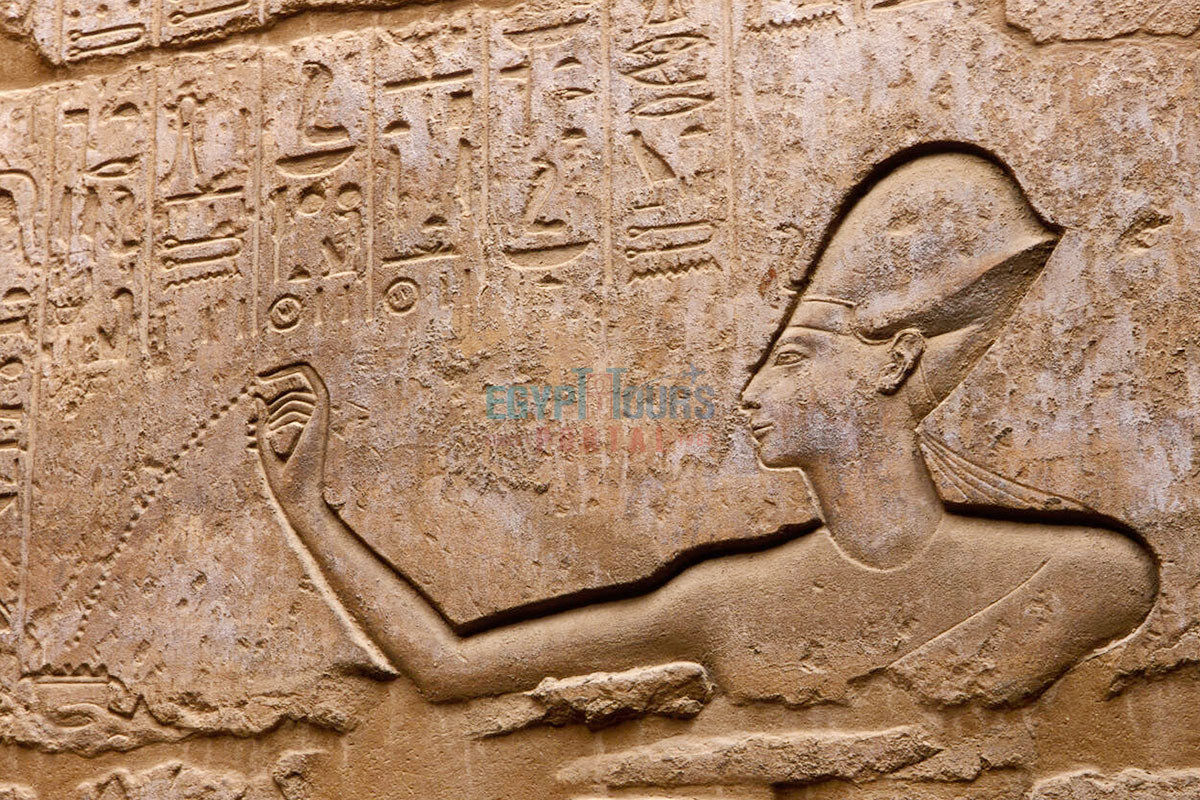 Medinet Habu Reliefs & Inscription – Egypt Tours Portal
Medinet Habu Reliefs & Inscription – Egypt Tours Portal
All the inscriptions and reliefs of Medinet Habu contain many majestic scenes of daily life, military campaigns, and religious ceremonies. The reliefs and inscriptions at Medinet Habu provide a wealth of facts and information about ancient Egyptian history, art, and culture showcasing the life and reign of Ramesses III and the religious practices of the time. One of the most important displays includes the depiction of the battle of the Delta where Ramses III defeated the sea People.
There are a number of religious scenes showcasing the king’s titulary, dedicatory inscriptions, offerings, and prayers to the gods, displaying all the devotion of the ancient Egyptian society. The entire complex is a living museum filled with a number of detailed artwork and hieratic graffiti. All these reliefs & inscriptions have been the subject of the excavation of skilled Egyptologists and archaeologists who attempted to understand the events and religious practices of the New Kingdom period in ancient Egypt.
Medinet Habu Facts
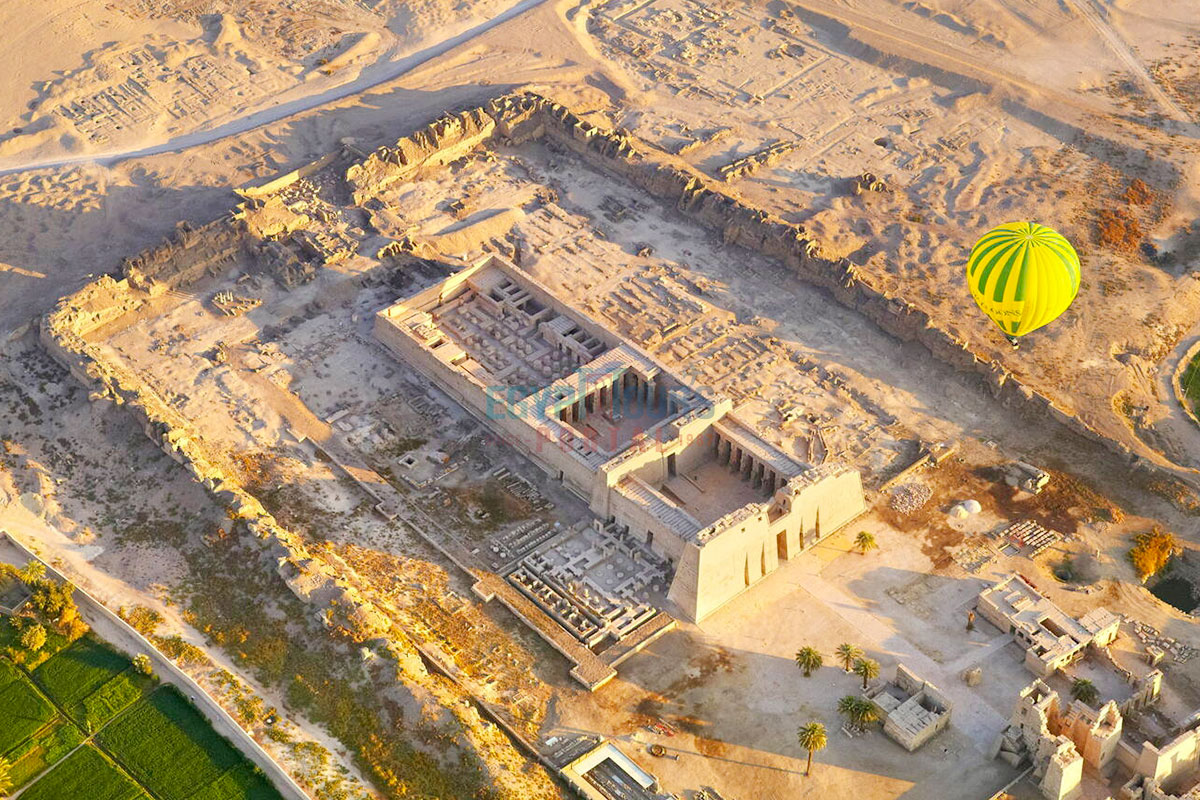 Medinet Habu Facts – Egypt Tours Portal
Medinet Habu Facts – Egypt Tours Portal
- Medinet Habu contains a magical mortuary temple of Ramesses III that displays the heritage of the powerful pharaoh during his reign.
- The complex is filled with a number of epic, well-preserved reliefs, and inscriptions, which provide insight into ancient Egyptian history and religious practices.
- It was created around the 12th century BCE during the New Kingdom period of Egypt. It contains a number of majestic monuments such as the Temple of Amun, the Temple of Ramesses III, the Temple of Ay and Horemheb, and more.
- The Complex has a number of magical buildings that are made of a combination of temples, palaces, surrounding walls, churches, and many more that uncover various enriching facts.
Medinet Habu Gallery
Conclusion
The land of Thebes is the world’s greatest open-air museum filled with the finest examples of ancient architecture showcasing the greatest monuments ever created in the history of mankind, offering a gate to the legendary history of the New Kingdom. Luxor tours allow visitors to explore the ancient city of Luxor in Egypt. Don’t miss out on the opportunity to explore the rich history and culture of Luxor. Book your tour today and experience the wonders of the ancient city for yourself!”
Availability: Everyday
Tour to Luxor West Bank
Tour to Explore the West Bank of Luxor Tour to Luxor West Bank is like stepping into…
Tour Location: Luxor…
Availability: Everyday
Edfu & Kom Ombo Tour from Luxor
Tour to Edfu and Kom Ombo Edfu & Kom Ombo tour from Luxor is a divine journey th…
Tour Location: Edfu/Kom Ombo…
Related Post
A shocking documentary proves that mermaids do exist
SHOCKING Revelation: Thuya, Mother of Queen Tiye, Was the Grandmother of Akhenaten and Tutankhamun—What Ancient Egyptian Secrets Did She Leave Behind?
Breaking News: Astonishing Discoveries at Karahan Tepe Confirm an Extraterrestrial Civilization is Hiding on Earth, and NO ONE Knows!
Breaking News: Researchers FINALLY Discover U.S. Navy Flight 19 After 75 Years Lost in the Bermuda Triangle!
NASA’s Secret Investigation: Uncovering the Astonishing Mystery of the UFO Crash on the Mountain!
Explosive UFO Docs LEAKED: Startling Proof That Aliens Ruled Ancient Egypt!